If you appreciate exotic mushrooms, then chanterelles are most likely on your radar. The attractive, golden hue of these fungi makes them a coveted delicacy with their unique and enticing fruity scent. It tantalizes the taste buds and provides invaluable health benefits like antioxidants, vitamins, and minerals that can help strengthen your body’s immunity system. Learn how to find chanterelle mushrooms.
Understanding the process is necessary now that you’re ready to forage for chanterelles. Do you know how to recognize them accurately? How do you differentiate between poisonous look-alikes? Furthermore, can you harvest responsibly and store them suitably so they don’t go bad or lose flavor quickly? In this guide, we’ll teach everything needed in order to become a successful mushroom hunter!
What Are Chanterelle Mushrooms?
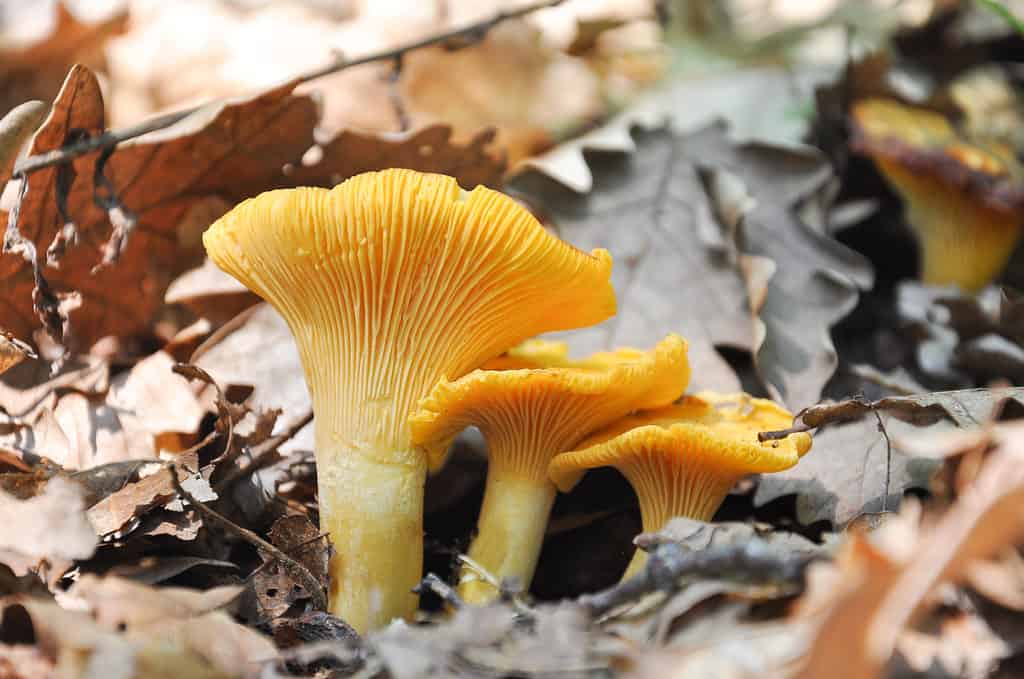
©Ivan Marjanovic/Shutterstock.com
Chanterelle mushrooms belong to the genera Cantharellus, Craterellus, Polyozellus, and Gomphus. They have a funnel-shaped cap, a wavy margin, and a smooth or slightly wrinkled surface. Also, the cap is usually yellow, orange, or white. However, some species can be red or black.
The underside of the cap has forked ridges or folds instead of true gills, which run down the stem. The stem is tapered toward the base. They also have a fruity aroma that resembles apricots and a peppery taste that adds a kick to any dish.
Chanterelles are not easy to cultivate, so they are mostly harvested from the wild by foragers and mushroom hunters. The name chanterelle has its root in the Greek word “kantharos“, which translates to “cup” or “tankard,” alluding to their general shape.
Where Do They Grow?
Chanterelle mushrooms grow on forest floors near coniferous or deciduous hardwood trees. They’re mycorrhizal fungi that basically form a symbiotic relationship with certain trees. They exchange nutrients and water with their host plants through their root-like structures called mycelia. In addition, chanterelle mushrooms are widely distributed worldwide and can be found in Europe, North America, Asia, Africa, and Australia.
Common Varieties of Chanterelles in North America
Depending on your location or travel destination, you may come across various kinds of chanterelles. Below are some common types you can typically find in North America:
Golden Chanterelle (Cantharellus cibarius)

©muuraa/Shutterstock.com
This chanterelle variation is highly favored and extensively dispersed. Its cap, which measures up to 10 cm in diameter, boasts a vibrant yellow or orange hue, while its stem is dense and sleek, narrowing towards its foundation. Also, it thrives near hardwood or coniferous vegetation and exhibits a robust, fruity fragrance.
Pacific Golden Chanterelle (Cantharellus formosus)
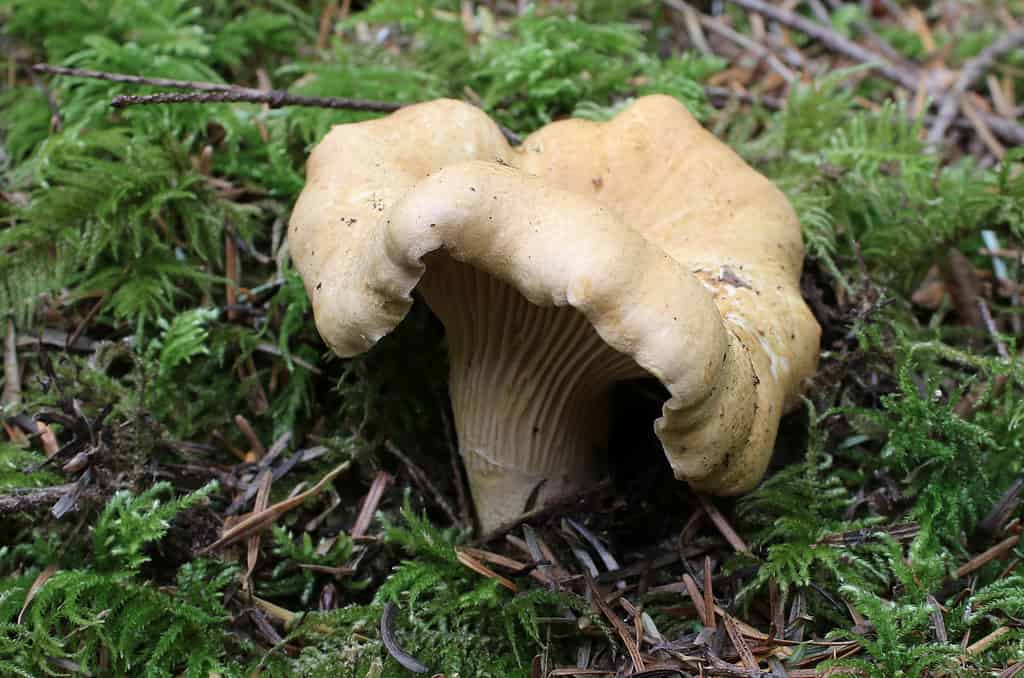
©Randy Bjorklund/Shutterstock.com
The Pacific golden chanterelle is a close relative of the golden chanterelle, but it’s more common in the Pacific Northwest region of North America. It has a funnel-shaped cap and is orange to yellow. The cap is smooth and has gill-like ridges on the underside that typically exhibit a pinkish hue.
Pacific golden chanterelle has a fruity smell and also a mild taste that most people find appealing. It grows in association with western hemlock and Douglas fir trees.
White Chanterelle (Cantharellus subalbidus)
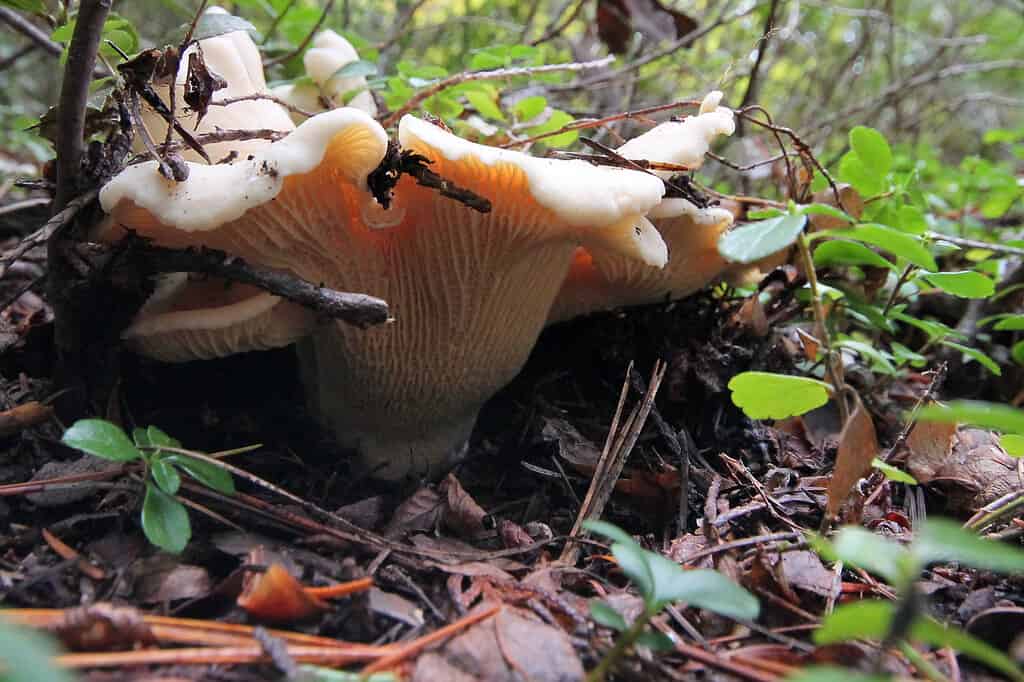
©iStock.com/randimal
The white chanterelle (Cantharellus subalbidus) is a fungus native to California and the Pacific Northwest region of North America. It’s similar in appearance to other chanterelles. However, its cream-to-white color that darken to yellow-orange with age or bruising.
The stem is 2–7 cm (1–3 inches) tall and 1–5 cm (0.4–2 inches) wide, tapered to the base. It has a sweet flavor that’s less fruity than the golden chanterelle. Additionally, it grows in association with conifers, especially Douglas-fir, pine, hemlock, and madrone.
Cinnabar Chanterelle (Cantharellus innabarinus)

©K Quinn Ferris/Shutterstock.com
The cinnabar chanterelle is a small and delicate chanterelle with a bright red or orange color that fades with age. The false gills are well-spaced and also have the same color as the cap or paler.
Cinnabar chanterelle is edible and good, but it has high water content (up to 90%), so it needs to be cooked well to release the excess moisture. Some people prefer to dry sauté without oil or butter, while others like adding fat to enhance the flavor.
Smooth Chanterelle (Cantharellus lateritius)
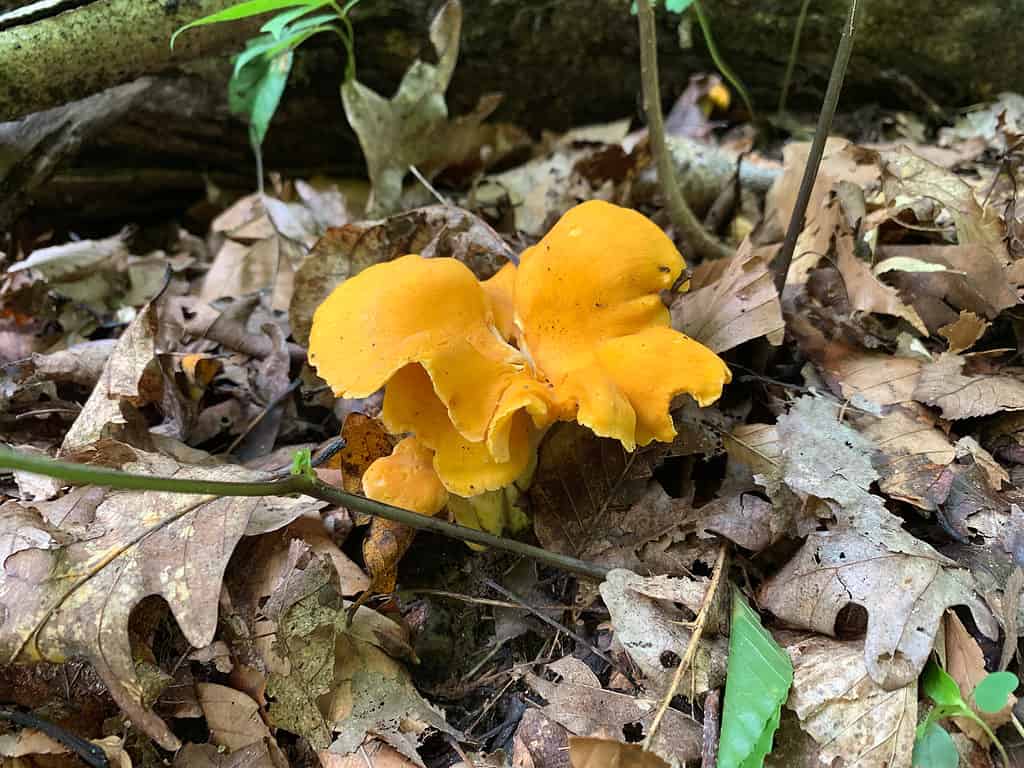
©CampSmoke/Shutterstock.com
The smooth chanterelle is a medium-sized mushroom reaching up to 12cm tall. It has a bright yellow to orange cap that is convex to funnel-shaped, with wavy margins and a hollow center. The cap surface is dry and covered with a thin layer of hair. However, unlike other chanterelles, the smooth chanterelle has a smooth or slightly wrinkled undersurface.
The stem of the smooth chanterelle is also yellow to orange. It can be straight or curved and sometimes tapered at the base. The mushroom’s flesh is firm and white, with a pleasant smell and taste.
Small Chanterelle (Cantharellus minor)
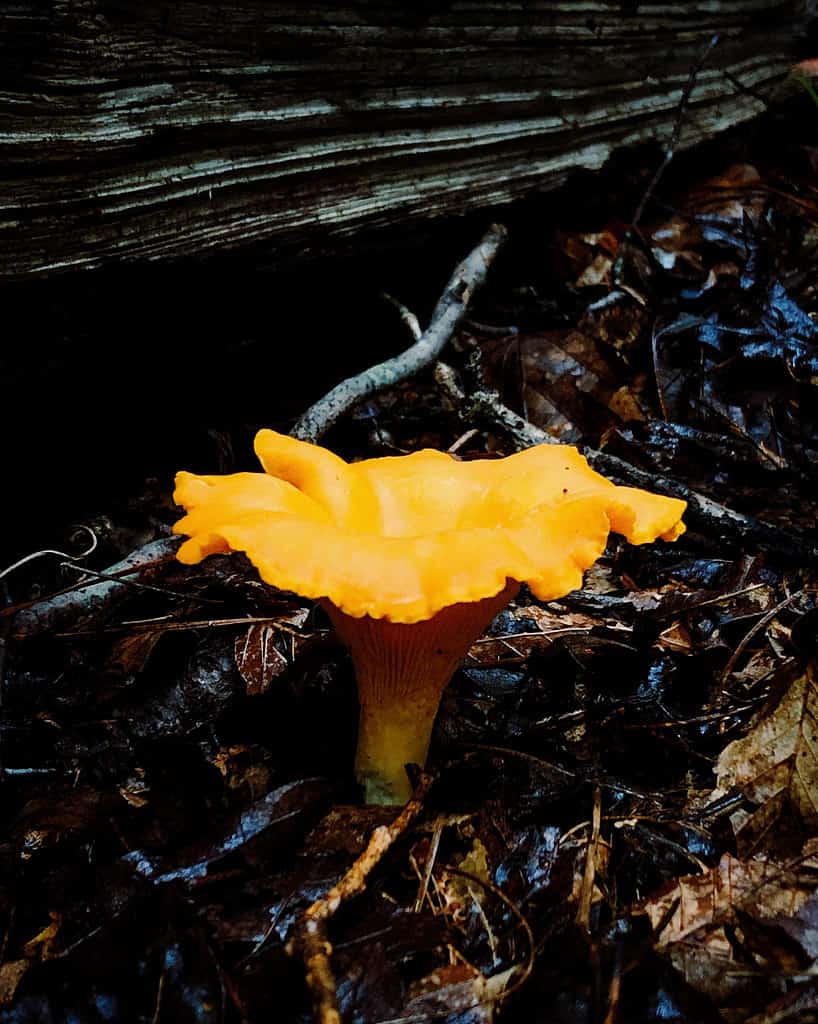
©iStock.com/Wirestock
Small chanterelle is one of the smallest species of the genus Cantharellus. It usually grows in moss and has more slender proportions than golden chanterelle.
The stem is less than 4 cm (1.6 inches) tall, slender, equal, or tapering slightly to the base. The flesh is thin, yellowish to orangish, with no distinctive odor or taste. The spore print is pale yellowish.
The small chanterelle’s cap ranges from 0.5 to 3 cm (0.2 to 1.2 inches) in width and has a convex and slightly depressed shape with a central knob. At times, it takes on a funnel-shaped appearance. However, its false gills are decurrent, well-developed, distantly spaced, and colored like the cap or slightly paler.
Horn Of Plenty (Craterellus cornucopioides)

©SariMe/Shutterstock.com
Horn of Plenty is also known as the trumpet of the dead or black chanterelle. It has a distinctive shape that resembles a funnel or a horn. The mushroom is usually almost black and blends in with the leaf litter on the forest floor.
The Horn of Plenty has a rich history and symbolism in different cultures. In Greek mythology, it was associated with the cornucopia, the horn of the goat Amalthea that could provide any food or drink its owner wished. It was a symbol of abundance and prosperity.
In France and Italy, however, it was called trompette de la mort or trombetta dei morti, meaning trumpet of the dead. Some say this name came from the belief that the souls of the deceased played the mushrooms as trumpets.
Flame Chanterelle (Craterellus ignicolor)
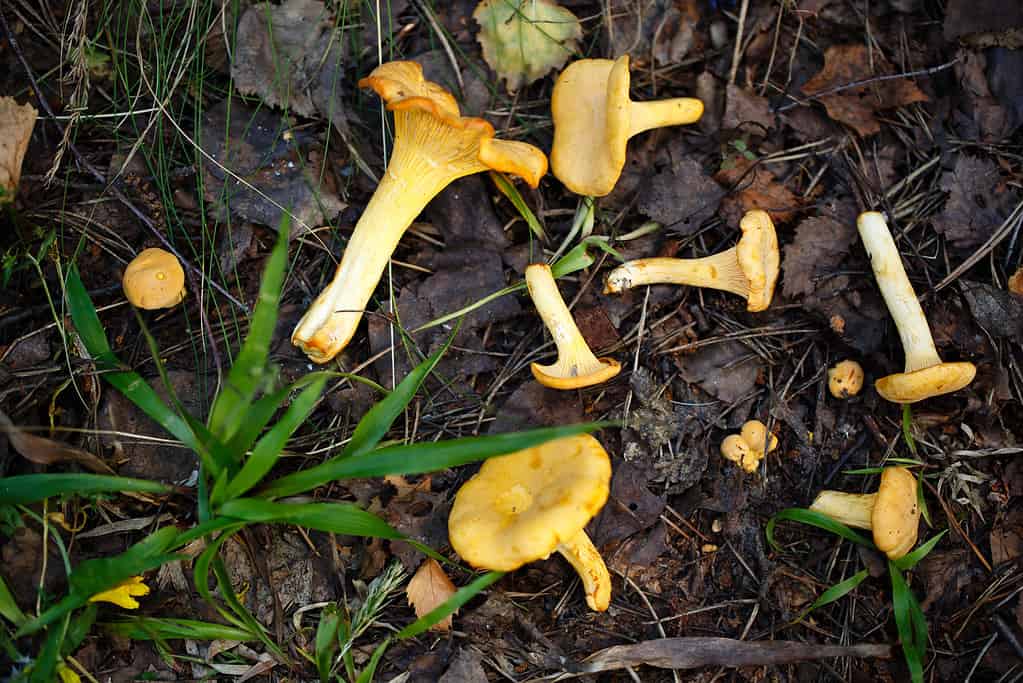
©iStock.com/Nadja Dorofeeva
The flame chanterelle is also known as the yellow foot. It’s smaller, usually ranging from 2-6 cm in height. It has a funnel-shaped or vase-shaped cap that often has a perforated center. The cap is yellow to bright orange. The underside of the cap has blunt false gills that run down the stem. Also, the stem is hollow, waxy, and bright orange to yellow.
Flame chanterelle has no distinctive smell or taste but can sometimes have a pleasant fruity aroma. You can use it in various dishes, especially soups, stews, and sauces. It has a thin flesh that cooks quickly and also absorbs flavors well.
How To Find Chanterelle Mushrooms
Before you head out to the woods, make sure know how to find chanterelle mushrooms. Have the following items with you:
A Mushroom Identification Guide or App
Using a mushroom identification guide or app will help you distinguish chanterelles from other mushrooms, especially those that look similar but are poisonous. You can consult an expert or join a local mushroom club for guidance.
A Basket or A Paper Bag
These are better than plastic bags for collecting mushrooms. They allow air circulation and prevent moisture buildup. Plastic bags can make mushrooms spoil faster and lose their flavor and texture.
A Knife or Scissors
These are useful for cutting the mushrooms from the ground, leaving some of the stems behind. This technique aids in preserving the mycelial network, the underground system of fungal cells responsible for mushroom production. Leaving some stems behind can help the mushroom regenerate and grow again.
A Brush or a Cloth
These are handy for cleaning the mushrooms of dirt and debris. You can also use your fingers to rub off any dirt gently. Avoid washing the mushrooms with water, as it can make them soggy and lose flavor. To find chanterelle mushrooms, follow these steps:
Step 1: Do Your Research
Before you head out to the woods, make sure you know what chanterelles look like and where they grow. You can use books, websites, or apps to learn about chanterelle identification and distribution. You can also join a local mushroom club or group to get advice from experienced foragers.
Step 2: Choose the Right Time and Place
Chanterelles typically grow from late summer to early fall. They prefer moist and shady areas with rich soil and leaf litter. Look for them under coniferous or hardwood trees, especially pine, oak, birch, beech, or spruce.
Step 3: Scan the Ground Carefully
Chanterelles can be hard to spot at first glance because they blend in with the leaves and pine needles. You may need to get down on your knees and look closely at the ground. Look for their characteristic shape and color. Moreover, check for their forked folds underneath the cap. They often grow in clusters or groups, so if you spot one, chances are there are more nearby.
Step 4: Check the Smell and Taste
Chanterelles have a fruity aroma that resembles apricots or peaches. They also have a mildly peppery taste that adds flavor to dishes. You can test a small piece of mushroom by chewing it and spitting it out. Never eat any mushroom that you are not 100% sure of its identity.
Common Look-Alikes of Chanterelles
It is important to know how to find chanterelle mushrooms accurately. Here are some common look-alikes of chanterelles:
False Chanterelles (Hygrophoropsis aurantiaca)
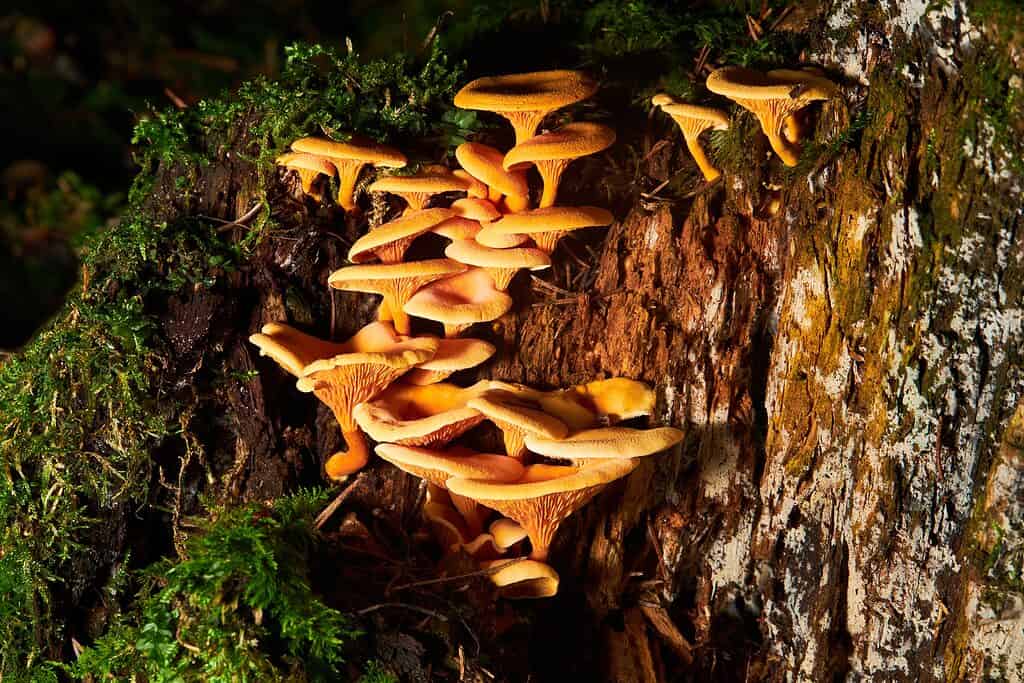
©krolya25/Shutterstock.com
False chanterelles are a species of fungus in the family Hygrophoropsidaceae. They have an orange color, a funnel-shaped cap with a felt-like surface, and thin gills that run down the stem. False chanterelles belong to the order Boletales, meaning they’re more closely related to Boletes than true chanterelles. They aren’t considered deadly poisonous but are not recommended for consumption.
Jack-O-Lanterns (Omphalotus olearius)
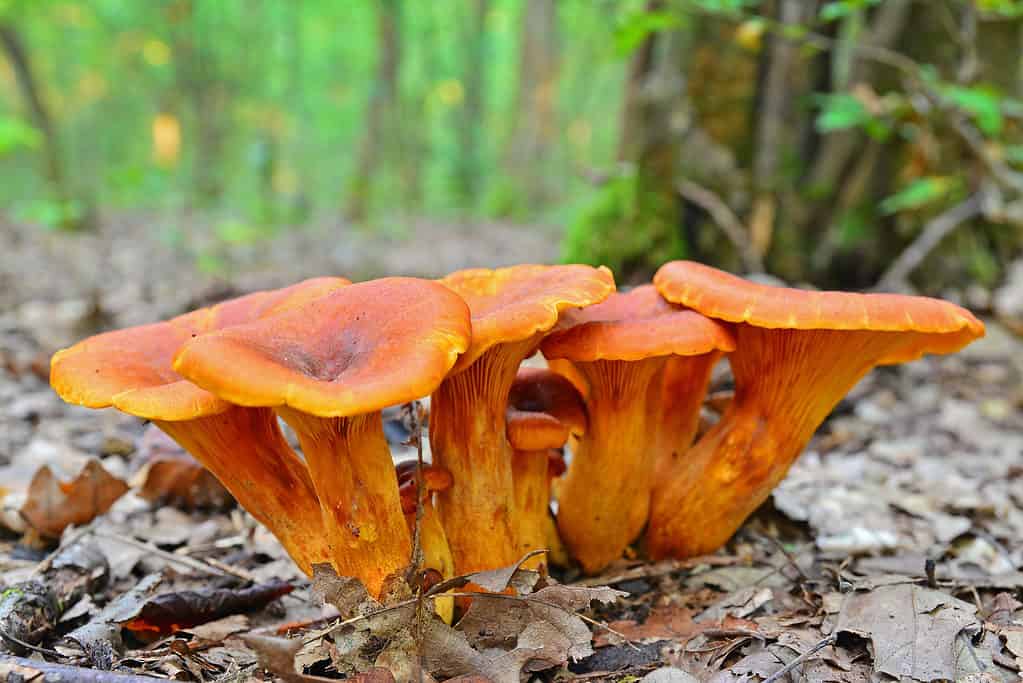
©bogdan ionescu/Shutterstock.com
Jack-o-lanterns are orange-gilled mushrooms that look similar to some edible chanterelles. They grow on decaying wood or at the base of hardwood trees. The jack-o-lanterns have funnel-shaped caps and thick stems. They usually grow in clusters and can be found from summer to autumn.
The most remarkable feature of Jack-o-lanterns is their bioluminescence, which means they can emit light in low-light conditions.
Only the gills of the mushroom glow, producing a blue-green color that the human eye can see after dark adaptation. The polish is caused by a chemical reaction between an enzyme called luciferase and a compound called luciferin, similar to how fireflies produce light.
Jack-o-lantern mushrooms are not deadly, but they are not edible. If you eat them, you will experience severe cramps, vomiting, and diarrhea since they contain a toxin called illudin S.
Woolly Chanterelles (Turbinellus floccosus)
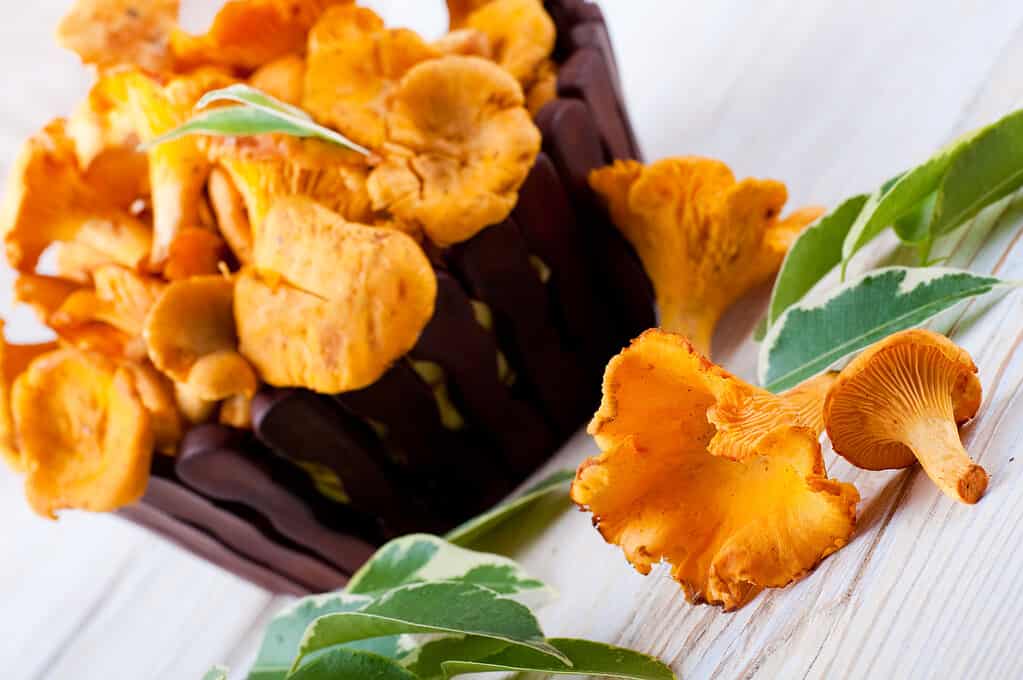
©iStock.com/Seqoya
The woolly chanterelles are members of the Gomphaceae family. They’re sometimes called scaly vases or shaggy chanterelles because of their distinctive appearance.
They have funnel-shaped caps that can reach up to 30cm (12 inches) in height. The caps are covered with soft, appressed scales that are dark orange to reddish-orange or brownish-orange in color. The underside of the cap has shallow wrinkles and ridges instead of gills.
The woolly chanterelle isn’t a highly sought-after edible mushroom, mainly because it causes gastrointestinal symptoms of nausea, vomiting, and diarrhea when consumed by most people.
How to Harvest Chanterelle Mushrooms
Once you have mastered how to find chanterelle mushrooms correctly, you can harvest them by following these steps:
- Step 1: Cut the mushroom at the base of the stem with a knife or scissors. Leave some of the stems behind to help the mushroom regenerate.
- Step 2: Place the mushroom in your basket or paper bag. Do not stack too many mushrooms on top of each other, as this can damage them.
- Step 3: Clean the mushroom with a brush or a cloth. Remove any dirt or debris from the cap and stem.
- Step 4: Store the mushroom in a cool and dry place.
How Can Chanterelles Improve Your Health?
Chanterelles are not only delicious but also nutritious. Here are some of the health benefits of chanterelles:
They Provide Vitamin D
Vitamin D is a vital nutrient that helps your body absorb calcium and maintain strong bones and teeth. It also supports your immune system, brain function, and mood. Unlike most mushrooms grown indoors, chanterelles are exposed to natural sunlight and naturally produce vitamin D. Half a cup of chanterelles can provide up to 100% of your daily recommended vitamin D intake.
They Boost Your Immunity
Bursting with antioxidants and a broad scope of beneficial nutrients, like beta-carotene, flavonoids, polyphenols, and ascorbic acid – chanterelles are quite the nutritional powerhouse. Not only do they protect against any damage caused by harmful free radicals that can lead to cancer incidence or inflammation, but their potential role in safeguarding your health from many possible diseases seems invariably integral!
They Support Your Eyesight
Chanterelles are an excellent source of vitamin A, essential for supporting optimal eye health and maintaining good vision. This essential nutrient aids in adapting your eyes to varying levels of light and prevents night blindness. Additionally, it shields your eyes from infections and age-related macular degeneration (AMD), a primary contributor to vision loss among the elderly.
They Enhance Your Brain Function
Chanterelles offer a bevy of B vitamins, comprising niacin, pantothenic acid, and riboflavin. These essential nutrients improve cognitive functioning by enhancing communication between brain cells – an efficient defense against Alzheimer’s or dementia.
They Regulate Your Blood Pressure
Potassium, a key mineral found in chanterelles, is vital for balancing bodily fluids and electrolytes. Moreover, it helps to lower blood pressure by easing tension in vessels and countering sodium’s effects. High blood pressure increases the susceptibility to encountering dangerous illnesses like cardiovascular disease, stroke, kidney disorder, and diabetes.
Enjoy Safe and Responsible Chanterelle Hunting
Chanterelle mushrooms are a culinary delight that can invigorate your plates and well-being. By mastering the art of locating them, you’ll experience both the joys of foraging and reaping what you sow.
But remember: when it comes to harvesting chanterelles, one must exercise caution and vigilance in order to ensure mindful collection practices. Avoid confusing them with toxic mushrooms and leave some behind for future generations. With these tips in mind on how to find chanterelle mushrooms and you can have a fun and rewarding chanterelle hunting adventure.
The post How to Find Chanterelle Mushrooms appeared first on AZ Animals.
from Animal News, Facts, Rankings, and More! - AZ Animals https://ift.tt/64zwpr8